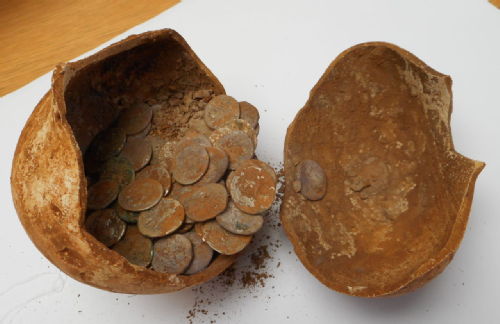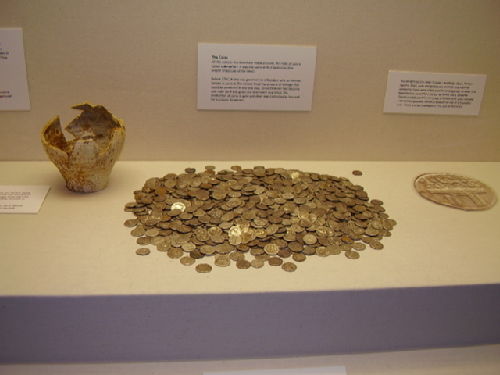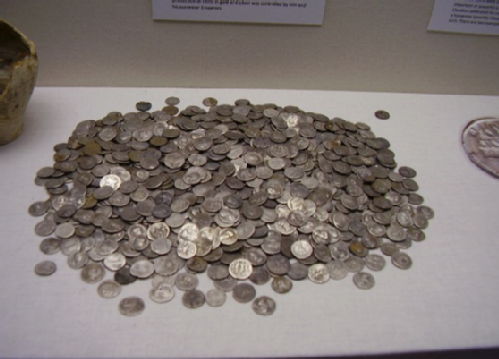All 2 entries tagged South Warwickshire Hoard
No other Warwick Blogs use the tag South Warwickshire Hoard on entries | View entries tagged South Warwickshire Hoard at Technorati | There are no images tagged South Warwickshire Hoard on this blog
March 26, 2019
What's in a Hoard?
 |
| The second Southwarwickshire hoard in a pot |
What indeed? Those living in Leamington may well have seen in the local press a report of the Warwickshire Museum’s intention to fundraise an initial sum of £3,000 towards the acquisition of a hoard of Roman denarii found in 2015 at a site atop the Edge Hill escarpment in south Warwickshire. This is in addition to submissions for more substantial funding from national bodies.
This is not the first hoard, though, that has turned up in the area, nor indeed the largest. One summer evening in 2008 a metal detectorist was on the point of giving up his unproductive search for material in an area a mere couple of hundred yards from the latest hoard, when his equipment began to register a significant find. Helped to unearth this by members of a local archaeological group who happened to be in the vicinity, it was eventually surrendered to the Warwickshire Museum and began its passage through the obligatory processes of the Treasure Act , where its status was established, and thence to the British Museum for valuation. At this point delay set in, principally because of the discovery of the Staffordshire Hoard of gold artefacts, but in time the hoard, valued at £52,000 (divided between the finder and landowner), became available for the Warwickshire Museum to acquire, something achieved thanks to grants by a number of national bodies. By this stage I had already had sight of the material and was able to begin cataloguing what turned out to be 1153 coins covering a range of dates from 194 BC to AD 63/4 in the reign of the emperor Nero. That denarii should remain in circulation for so long should come as no surprise since these coins were of high value (a basic soldier at the time earned 225 denarii a year), so were hardly small change. The catalogue was published as a British Archaeological Report (British Series) 585 in 2013 and is in the Warwick University Library (CJ 1101.I7). The hoard itself, and the pot in which it was found (originally sunk into the wall of a round structure) are well displayed in all their splendour within the Warwickshire Museum in the centre of Warwick.
Turning to the latest hoard there are important differences, which become only too clear when comparing the valuation placed upon them. To begin with, only 440 coins are involved, many of them heavily encrusted with soil or adhering together, having been buried beneath what might have been a threshold in an area where massive wall structures attest to a substantial Roman presence. As a result detailed identification of many awaits cleaning. As in the case of the first South Warwickshire hoard, though, there is a similarly significant proportion of coins dating from the Republican period beginning in the 140s BC, but importantly this second hoard extends its end-date into the reign of the emperor Vespasian, which began in AD 69. Significance? Well, it was preceded by a period of civil war following the suicide of Nero on June 9th AD 68 which saw a rapid turn-over of rulers – rapid measured in months: first Galba, then Otho and Vitellius before Vespasian won through. In addition to the coinages specifically issued in the name of these emperors, there are others anonymous in origin, together constituting a high proportion of the whole hoard, in fact. The resulting rarity of these coins with their short period of production, combined with the only slight wear they have suffered, means that the valuation given by the British Museum (even when the Warwickshire Museum has to find only half the total sum) outstrips that needed to purchase the whole of the earlier, much larger, hoard.
Stanley Ireland
Emeritus Reader
Classics & Ancient History
May 01, 2014
Coin of the Month: A Denarius of Augustus, Presenting a Dynasty
 |
| Denarius of Augustus |
This denarius of Augustus dates from 2-4 BC. The obverse features a laureate head of Augustus with the legend ‘CAESAR AVGVSTVS DIVI F PATER PATER PATRIAE’. The reverse depicts his two grandsons Gaius and Lucius stood facing each other, hands resting on a shield and spear, with a simpulum and lituus above. The legend around the edge reads ‘AVGVSTI F COS DESIG PRINC IVVENT’ and ‘C L CAESARES’ is written horizontally underneath the figures.
The coin is a useful example of the control that Augustus exercised over his personal image. The bust appears as that of a young man, however the emperor would have been in his 60s at this point. It is also illustrative of the problem of succession that faced an ageing Augustus. Having no sons of his own, the emperor had adopted his two grandsons and this coin is a clear message that they are the heirs to his title and powers. The beginning of their public careers is alluded to by the presentation of the title of “Leaders of the Youth”, as well as the appearance of both military and priestly images around them. Gaius’ and Lucius’ positions within the family are also emphasised by the fact that the two are explicitly called the sons of Augustus. Also, the prominent way in which ‘Caesares’ is placed upon the coin has clearly dynastic overtones, especially given that it was the name that Augustus himself took following his own “adoption” by Julius Caesar, which launched his political career. This theme is further continued on the obverse, where Augustus presents the title ‘Divi Filius’ (“Son of a God”) alongside that of ‘Pater Patriae’ (“Father of the Country”). By presenting himself as both son and father, Augustus is drawing the parallel to his own adoption as well as that of his grandsons and it is made clear that an imperial dynasty, with the successive handing down of powers, has been founded.
This particular denarius is contained within the South-Warwickshire Hoard of Roman denarii, which was discovered in 2008 by a local metal-detectorist. The hoard is comprised of 1153 silver denarii, with dates ranging from 190 BC to AD 64. It is one of the largest coin hoards from the Roman world and is made even more special by the fact that the pot in which the coins were buried has also survived. The South-Warwickshire Hoard was acquired by Warwickshire Museum, catalogued by Stanley Ireland and it is currently on display at the Market Hall Museum in Warwick.
 |
 |
The South Warwickshire Hoard in the Warwickshire Museum
This month's coin was chosen by Abigael Flack, a museum assistant at the Warwickshire museum. Abigael is interested in the presentation and reception of the Roman imperial regime, particularly in literature. Her MA thesis examined this theme in the biographies of Suetonius.
(Images courtesy of Sara Wear and Heritage & Culture Warwickshire.)
 Clare Rowan
Clare Rowan

 Please wait - comments are loading
Please wait - comments are loading

 Loading…
Loading…

